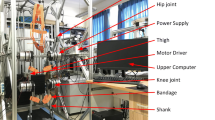Abstract
Recently, various rehabilitation robots have been developed for therapeutic exercises. Additionally, several control methods have been proposed to control the rehabilitation robots based on user’s motion intention. One of the common control methods used is torque-based impedance control. This paper presents an electromyogram-based robust impedance control for a lower-limb rehabilitation robot using a voltage-based strategy. The proposed control strategy uses surface electromyogram (sEMG) signals in place of force sensors to estimate the exerted force. In addition, the control is based on the voltage control strategy, which differs from the common torque control strategies. For example, unlike the torque-based impedance control, the controller is not dependent on the dynamical models of the patient and the robot. This is particularly important as the dynamic of the patient is both difficult to model precisely and changes during the rehabilitation period. These simplifications results in a significant reduction in calculation time. To illustrate the effectiveness of the control approach, a 1-DOF lower-limb rehabilitation robot is designed. Experimental sEMG-force data are collected and used to train an artificial neural network. Simulation results show that compared with a torque-based control approach, the voltage-based is simpler, less computational and more efficient while it considers the presence of actuators. Finally, we design an adaptive fuzzy system to estimate and compensate the uncertainty in performing the impedance rule. The adaptive fuzzy system has an advantage that does not need new feedback to estimate the uncertainty. The control approach is further verified by stability analysis. Simulation results show the efficiency of the control approach in performing some therapeutic exercises.













Similar content being viewed by others
References
Akdogan E, Arif Adli M (2011) The design and control of a therapeutic exercise robot for lower limb rehabilitation: physiotherabot. Mechatronics 21(3):509–522
Sharifi M, Behzadipour S, Vosughi Gh (2014) Nonlinear model reference adaptive impedance control for human-robot interactions. Control Eng Pract 32:9–27
Ju MS, Lin CCK, Lin DH, Hwang IS, Chen SM (2005) A rehabilitation robot with force-position hybrid fuzzy controller, hybrid fuzzy control of rehabilitation robot. IEEE Trans Neural Syst Rehabil Eng 13(3):349–358
Xu G, Song A, Li H (2011) Adaptive impedance control for upper-limb rehabilitation robot using evolutionary dynamic recurrent fuzzy neural network. J Intell Robot Syst 62:501–525
Houglum PA (2010) Therapeutic exercises for musculoskeletal injuries. Human Kinetics Publishers, Champaign
Bernhardt M, Frey M, Colombo G, Reiner R (2005) Hybrid force-position control yields cooperative behavior of the rehabilitation robot LOKOMAT. In: 9th International conference on rehabilitation robotics, ICORR2005, pp 536–539
Krebs HI, Hogan N, Aisen ML, Volpe BT (1998) Robot aided neurorehabilitation. IEEE Trans Rehabil Eng 6(1):75–87
Richardson R, Brown M, Bhakta M, Levesley MC (2003) Design and control of a three degree of freedom pneumatic physiotherapy robot. Robotica 21:589–604
Roberto M, Philip P (2004) Electromyography, physiology, engineering and non-invasive applications. IEEE Press Engineering in Medicine and Biology Society, Sponsor, 2
Samuel OW, Zhou H, Li X et al (2017) Pattern recognition of electromyography signals based on novel time domain features for amputees’ limb motion classification. Comput Electr Eng. doi:10.1016/j.compeleceng.2017.04.003
Li X, Samuel OW, Zhang X, Wang H, Fang P, Li G (2017) A motion-classification strategy based on sEMG-EEG signal combination for upper-limb amputees. J Neuroeng Rehabil 14(1):2
Jain RK, Datta S, Majumder S (2013) Design and control of an IPMC artificial muscle finger for micro gripper using EMG signal. Mechatronics 23(3):381
Dellon B, Matsuoka Y (2007) Prosthetics, exoskeletons, and rehabilitation (grand challenges of robotics). IEEE Robot Autom Mag 14(1):30–34
Wu S, Waycaster G, Shen X (2011) Electromyography-based control of active above-knee prostheses. Control Eng Pract 19(8):875–882
Kiguchi K, Kariya S, Watanabe K, Izumi K, Fukuda T (2001) An exoskeletal robot for human elbow motion support-sensor fusion, adaptation, and control. IEEE Trans Syst Man Cybern B Cybern 31(3):353–361
Rosen J, Brand M, Fuchs M, Arcan M (2001) A myosignal-based powered exoskeleton system. IEEE Trans Syst Man Cybern A Syst Hum 31(3):210–222
Kiguchi K, Rahman MH, Sasaki M, Teramoto K (2008) Development of a 3DOF mobile exoskeleton robot for human upper limb motion assist. Robot Auton Syst 56(8):678–691
Fleischer C, Hommel G (2008) A human-exoskeleton interface utilizing electromyography. IEEE Trans Robot 24(4):872–882
Moritani T, Muro M (1987) Motor unit activity and surface electromyogram power spectrum during increasing force of contraction. Eur J Appl Physiol Occup Physiol 56(3):260–265
Hogan N (1980) Mann, myoelectric signal processing: optimal estimation applied to electromyography—part1: derivation of the optimal myoprocessors. IEEE Trans Biomed Eng 27(7):382–395
Siegler S, Hillstrom HJ, Freedman W, Moskowitz G (1985) Effect of myoelectric signal processing on the relationship between muscle force and processed EMG. Am J Phys Med 64(3):130–149
Song R, Tong KY (2005) Using recurrent artificial neural network model to estimate voluntary elbow torque in dynamic situations. Med Biol Eng Comput 43(4):473–480
Kiguchi K, Hayashi Y (2012) An EMG-based control for an upper-limb power-assist exoskeleton robot. IEEE Trans Syst Man Cybern Part B Cybern 42(4):1064–1071
Ibn Ibrahimy M, Ahsan Md, Omran Khalifa O (2013) Design and optimization of Levenberg–Marquardt based neural network classifier for EMG signals to identify hand motions. Meas Sci Rev 13(3):142–151
Gopura RARC, Kiguchi K, Li Y (2009) SUEFUL-7: a 7DOF upper-limb exoskeleton robot with muscle-model-oriented EMG-based control. In: IEEE/RSJ international conference on intelligent robots and systems (IROS), pp 1126–1131
Kiguchi K, Tanaka T, Fukuda T (2004) Neuro-fuzzy control of a robotic exoskeleton with EMG signals. IEEE Trans Fuzzy Syst 12(4):481–490
Kundu S, Kiguchi K (2008) Design and control strategy for a 5 DOF above-elbow prosthetic arm. Int J ARM 9(3):61–75
Tucker MR, Olivier J, Pagel A, Bleuler H, Bouri M, Lambercy O, del R Millán J, Riener R, Vallery H, Gassert R (2015) Control strategies for active lower extremity prosthetics and orthotics: a review. J Neuroeng Rehabil 12(1):1
Malcolm P, Quesada RE, Caputo JM, Collins SH (2015) The influence of push-off timing in a robotic ankle-foot prosthesis on the energetics and mechanics of walking. J Neuroeng Rehabil 12(1):21
Kiguchi K, Tanaka T, Fukuda T (2004) Neuro-fuzzy control of a robotic exoskeleton with EMG signals. IEEE Trans Fuzzy Syst 12(4):481–490
Kiguchi K, Esaki R, Fukuda T (2005) Development of a wearable exoskeleton for daily forearm motion assist. Adv Robot 19(7):751–771
Fateh MM (2008) On the voltage-based control of robot manipulators. Int J Control Autom Syst 6(5):702–712
Fateh MM, khoshdel V (2015) Voltage-based adaptive impedance force control for a lower-limb rehabilitation robot. Adv Robot 29(15):961–971
Spong MW, Hutchinson S, Vidyasagar M (2006) Robot modelling and control. Wiley, New York
Herzog W, ter Keurs HEDJ (1988) Force-length relation of in vivo human rectus femoris muscles. Pflüg Arch 411(6):642–647
Sharifnezhad A, Marzilger R, Arampatzis A (2014) Effects of load magnitude, muscle length and velocity during eccentric chronic loading on the longitudinal growth of the vastus lateralis muscle. J Exp Biol 217(15):2726–2733
Wang LX (1997) A course in fuzzy systems and control. Prentice-Hall International, Inc., Upper Saddle River
Author information
Authors and Affiliations
Corresponding author
Rights and permissions
About this article
Cite this article
Khoshdel, V., Akbarzadeh, A., Naghavi, N. et al. sEMG-based impedance control for lower-limb rehabilitation robot. Intel Serv Robotics 11, 97–108 (2018). https://doi.org/10.1007/s11370-017-0239-4
Received:
Accepted:
Published:
Issue Date:
DOI: https://doi.org/10.1007/s11370-017-0239-4




